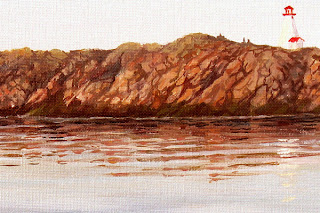Painting the sea is all about understanding how light and water interact. In many respects, painting calm water can be quite challenging. The interaction between light and water is much more subtle, and this subtlety is really less forgiving when you don’t do it justice.
Water allows light to pass through it, but the surface of water also acts like a mirror, reflecting light. How much is light you see from within the water and how much is reflected depends on the angle at which you are looking at the water.
My painting “Swallowtail Welcome” illustrates painting a very calm sea.
If you look at the painting, you will see that the water in the distance more closely resembles the colour of the distant sky. That is because the water is very calm and, like a sheet of glass, it reflects the sky of the distance. The closer you get to the horizon in the water, the closer to the horizon is the sky reflected.
As you come toward the foreground (if you can call it “ground” in a seascape) the water becomes darker. If you look at the sky, you will notice that the sky becomes darker overhead, and is paler near the horizon. Just as the water near the horizon reflects sky near the horizon, water nearer to you reflects the sky more overhead. So in the middle distance the water reflects the darker overhead sky.
As you come close, it gets more complicated: here in the very slight wave in the water, on the back side of the wave you have a reflection of the sky; on the near side you look into the water and see the greenish colour of looking down into the water. If anyone remembers their high school physics, you can remember that water acts like a prism and “bends” the light at the surface, bending it so you are looking more directly down into the water. It is because of this refraction that you see the green colour of looking down into the water even if your angle is not that directly down.
The sketch above crudely illustrates this. Relating the sketch to the painting, light from within the water is depicted greenish-blue on the near side of a ripple, the very light parts of a ripple are reflections of the horizon sky on the far side, and the blue parts of the ripples are reflections of the overhead sky on the near side of shallow wavelets in the middle distance.
Now, you may also notice that the water in front of the rocky point shows reflections of both sky and rocks, as bands of sky colour and bands of rock colour. In that case, the reflections on the ripples nearer to the horizon would be the rocky point and the reflections on the ripple with sky colour would be on a part of the ripple that would reflect more directly overhead. The white of the lighthouse would be reflected directly under it, in place of the rocks, with whie and sky being interspersed.
Note the thin light line where water and shore meet; a light ripple occurs there. Also note the dark seaweed covered rocks near the water. It is important to note that the band of seaweed should never vary too much in level from the water, as seaweed always grows in well defined tidal zones.
Note the thin light line where water and shore meet; a light ripple occurs there. Also note the dark seaweed covered rocks near the water. It is important to note that the band of seaweed should never vary too much in level from the water, as seaweed always grows in well defined tidal zones.
We’ll take a look at how light and water interact in other sea and light conditions in future blogs, but this calm sea helped illustrate some basics.




No comments:
Post a Comment